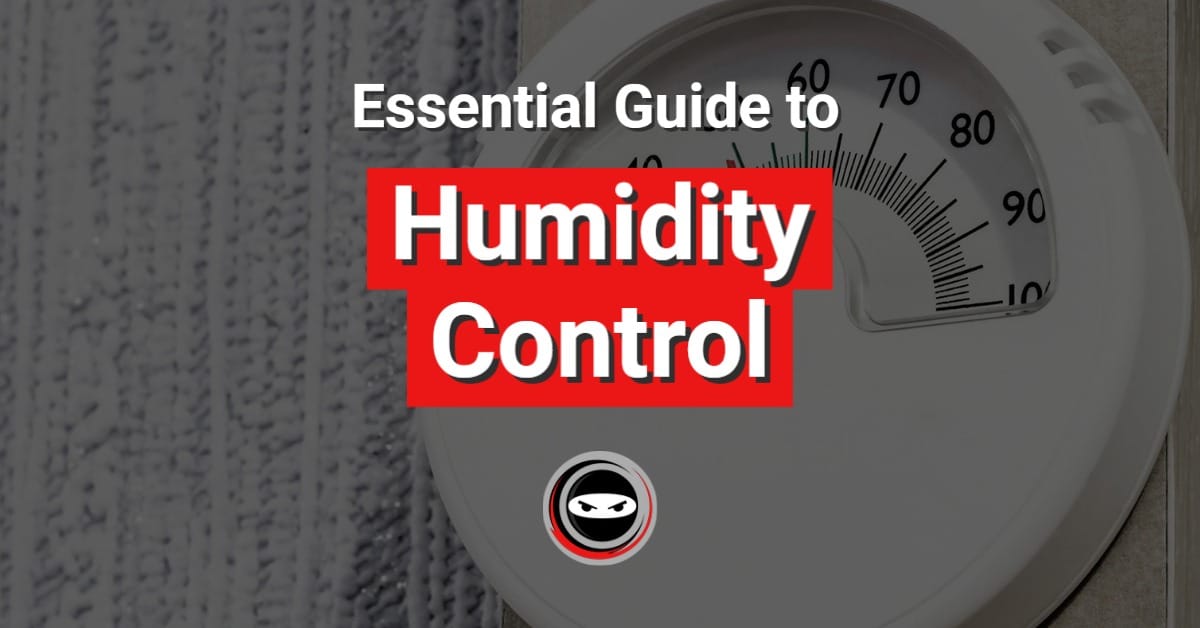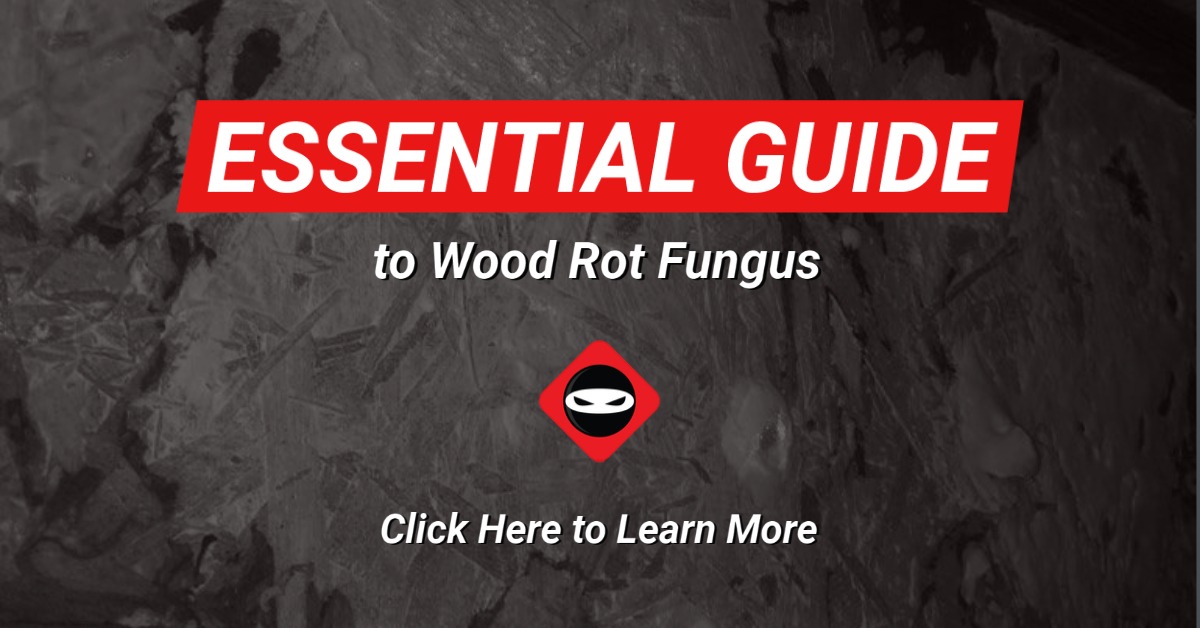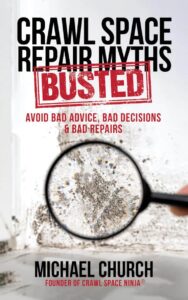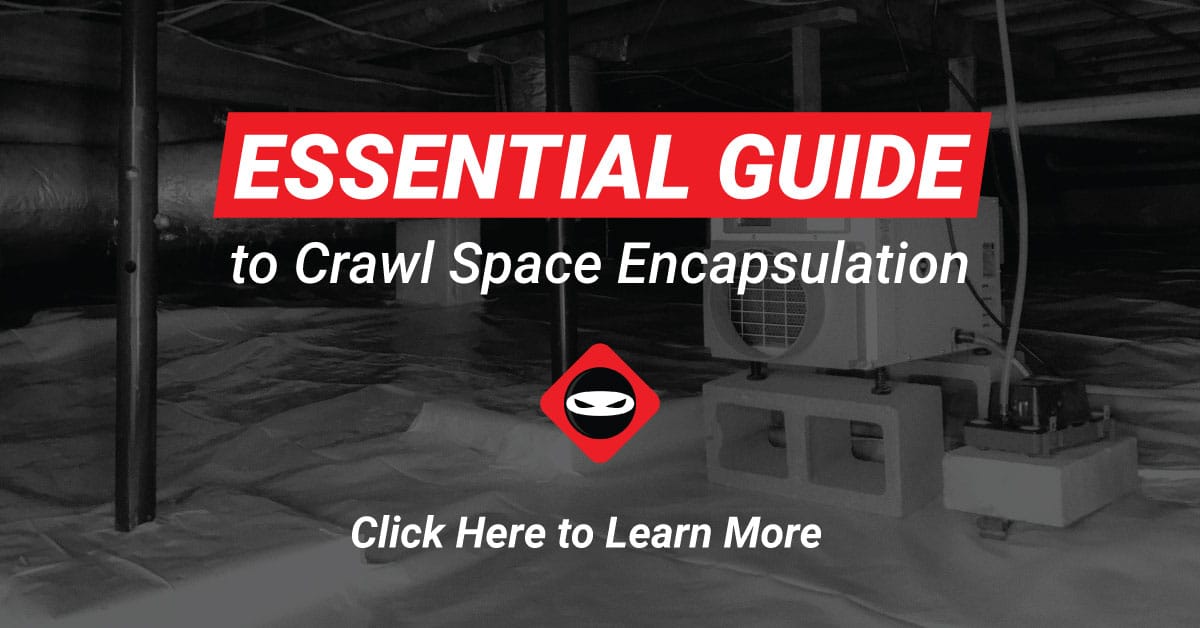What is the Best Humidity Level for your Crawl Space? Many homeowners ask this question and get very different answers depending on where the answer is coming.
We at Crawl Space Ninja feel like the range of humidity should be between 45% and 55% in most cases.
What is the Best Humidity Level to Keep Wood Dry?
Keeping the crawl space and basement relative humidity between 45% and 55% can keep wood relatively dry, and have the same affect on the air quality in the rest of your house.
When controlling humidity in your home there is no better place to start than the crawl space or basement.
The Stack Effect Causes Air to Rise
Due to the stack effect, air rises from the basement or crawl space up to the attic. The taller the home the faster the air will rise. The less air sealed the home the faster the air will rise. The rising air will carry moisture, mold and dust to all parts of your home.

Best Humidity Level for Your Garage
The garage is always overlooked when it comes to humidity control by many contractors. Many homes have garages that contain heating and air conditioning equipment. The HVAC can sweat when garage humidity is not kept in check. Rooms above the garage can also suffer from high humidity in the garage. Installing a garage dehumidifier can solve this problem. If your garage is not located over the basement or crawl space, where the dehumidifier is installed, the garage may suffer from high humidity.
Why Control Humidity in Your Home
We have found that many indoor air quality pollutants rely on high or very low humidity. Germs, bacteria and other indoor pollution can thrive in extremely low humidity as well as relative humidity over 60%. Too dry can be a problem on the wood in your home as well. Keeping the relative humidity between 45% and 55% will solve most of these issues.
Contact Crawl Space Ninja for Basement Waterproofing and Encapsulation
Please contact us to schedule your assessment to fix your crawl space, basement issue.
Do you need help with mold removal, crawl space encapsulation, crawl space insulation, vapor barrier, waterproofing, foundation repair, basement waterproofing, or controlling humidity in your crawl space?
If you live in Georgia, Delaware, North Carolina, South Carolina, Tennessee, or Kentucky, Crawl Space Ninja can help!
Also, let us know in the comments below if you have an idea for a new blog topic.
DIY Crawl Space Repair
Perhaps you’d like to tackle your own crawl space repair. Visit our DIY Store.
Join Crawl Space Ninja as an Owner
Learn about Crawl Space Ninja Franchise opportunities.


Michael Church’s Crawl Space Repair Myths-Busted book was written to help you Avoid Bad Advice, Bad Decisions, & Bad Repairs.
“This book is the Cadillac for crawl space information and Michael Church is your experienced driver. What can I say? It’s just an amazing read.” 5.0 out of 5 stars The real deal.



14 thoughts on “Best Humidity Level for Crawl Space”
We had our dihumidifier company raise our crawl space dihumidifier from 42% to 55%. Unfortunately the unit was raised to 65% and it caused my dihumidifier to ice over. We need to send our Sante Fe in for a repair or replacement. Our hardwood
flooring snap, crackle & pops since the flooring was installed. Our new dihumidifier company told us Our interior % needs to be raised we run 37-42%. I have asthma and it is unbearable to breathe in our house. I am concerned because we will be turning in the heat, I don’t want to lose our hardwood flooring. What should our hygrometer be in the house and in the crawl space? Thank you
With your asthma I’d suggest you ask your doctor that question. In some cases, you may need a dehumidifier in crawl space and a humidifier in living space, especially in winter and given your health conditions. Many experts say between 45-55% is best in all parts of home but if you run heat that can lower the humidity quickly. Here is a video of Brian explaining that situation where he lives. https://youtu.be/rjRQhsyFluo Hope that helps.
My Basement vents are closed all year long. In winter my basment RH levels are low around 30%, and around 70% in the summer. To help with this and keep a constant 50% RH year around , i use humidifiers in the winter to raise my levels and dehumidifiers in the summer to drop my levels.
Since my vents are not air tight, there is little infiltration of outside air all year but my equipment is able to keep my crawlspace at 50% all year round.
Is there something else you would recommend or see any concerns with what I’m doing ?
I have 3 humidistats in the crawlspace spread out to get more accurate readings through out the space.
Thanks
Sounds like you are doing everything needed…great job! What part of the country do you live?
We live in Upstate SC, I have a 130 year old “salt box” 2 story mill House.
We just remediated and encapsulated the crawl space and bought an aprilaire dehumidifier from you. Installing it now.
Last summer (pre encapsulation) the humidity in our living space would run 70 to 80%. In the winter it was between 30 and 40%. Even though nights are still freezing, we have a warm days like today where it’s 60 outside, and plugging in the April layer for the first time it is reading that my relative humidity in my crawl space is 59%.
A lot of the home (exterior walls) have no vapor barrier, except for the indoor paint 🤣.
We’re terrified by mold coming back, and want to set our dehumidifier at the lowest recommendation of 45%.
In an old house that so open, would there be any cause or concern to set the dehu this low in the crawl space? Is there any reason it would be better to go 50, or 55? Or is this really just a preference?
Hi David, 45% is a good setting too. Keep in mind they operate +/- 3% to 5% so if you set on 45% it could get to 40% then shutoff allowing it to work its way back up to 46% before coming on again. Based on age of your home I think 45% is a good setting so it can assist better with the rest of the non insulated part of the house. And allow the paint vapor barrier to work better :). Hope that helps and thank you for your business!
We have recently fully encapsulated our crawlspace and put down new vapor barrier. Is it necessary to add a dehumidifier? Will dropping a vent down in the crawl space and heating and cooling it help control the humidity level down there without having the expense of the dehumidifier? Or is a vent even necessary?
Hi Mike, great question and we get that one a lot. We did a video Crawl Space Humidity Control 101. I think this can help. Thanks. https://youtu.be/9nCGqp63-MI
Super impressed with your great videos and products! I just moved to Portland OR and have a 1600 sq ft single story, 1985 house with a 30″ tall crawl space. There is a good plastic vapor barrier on the ground and no water even after rains; there are some little windows with styrofoam shoved in them and one is just open. I put a humidity meter down there in January, and the RH was about 60% in winter but now has risen to 80% with recent rains. This seems high. But, there is no evidence of mold growth, no smells, and it has probably been this way for years. Do you think I need to do anything or add a dehumidifier?
Hi Steve, sometimes the mold can be unseen so I would get a wood moisture meter and see if the wood in the crawl space is above 20%. I have seen older hoe with good oak wood that did not appear to grow mold. I would like you to still consider a dehumidifier because the high humidity may lead to mold in the future and typically high humidity can create other indoor air quality issues like dust mites. Keeping humidity between 45-55% is what we recommend. hope that helps. Here is an article with a chart that shows what levels of humidity other indoor pollutants can thrive in. Even too low is not recommended. Hope that helps. https://crawlspaceninja.com/blog/effective-virus-protection-by-controlling-humidity/
Humidistat on dehumidifier stopped working so I run it continuously. Humidity in sealed crawl space is around 25%. Is this okay or am I causing unseen issues
That’s pretty low, I think it would be best to keep above 40% if possible. Here is an article showing a graph for optimal humidity levels and what can occur to air quality if outside those levels. Hope that helps. https://crawlspaceninja.com/indoor-air-quality/effective-virus-protection-by-controlling-humidity/
Good morning! I’m so glad I found your site! It’s very informative! We live in the Charleston, SC area and bought a house in late summer of 2019 with an encapsulate crawl space. My husband nor I had owned a home with a crawl space before so it’s definitely been a learning process. The sensor and thermostat that the previous owner had has consistently been reading 65-70% humidity levels and all the vents were open. After finding your site, I closed all the vents and convinced my hubby to investigate a little more in the crawl space and although everything was working the dehumidifier was set to a level 3 so it wasn’t kicking on as often as it should have The dehumidifier we have only has options 1-5 not a percentage. It has now gotten to 46% but how do we know what damage has been done over the past few years? Also our electricity bill has risen significantly since he adjusted the settings so I was also curious how to know if the dehumidifier is big enough for the space. Thanks in advance for any feedback you may have!
Hi Amy, the turn knob dehumidifiers are tough to know what to set on. The Aprilaire style dehumidifiers run on a set point so it is more efficient plus some models are EnergyStar certified. Usually model is based on amount of moisture it pulls from the air. Here is our DIY store that shows models we carry and sizes. Most crawl spaces under 2,000 that are encapsulated properly can use the E070 but if the system was not done well an E100 may be best. https://diy.crawlspaceninja.com/dehumidifiers/ Inspecting the crawl space for visible signs of mold or odors may be best way to see what damage if any was done. You can also take surface mold tests to see if the wood is growing mold if you smell a musty odor but don’t see visible mold. https://diy.crawlspaceninja.com/mold-test-kit-diy-1-test/ Hope that helps.